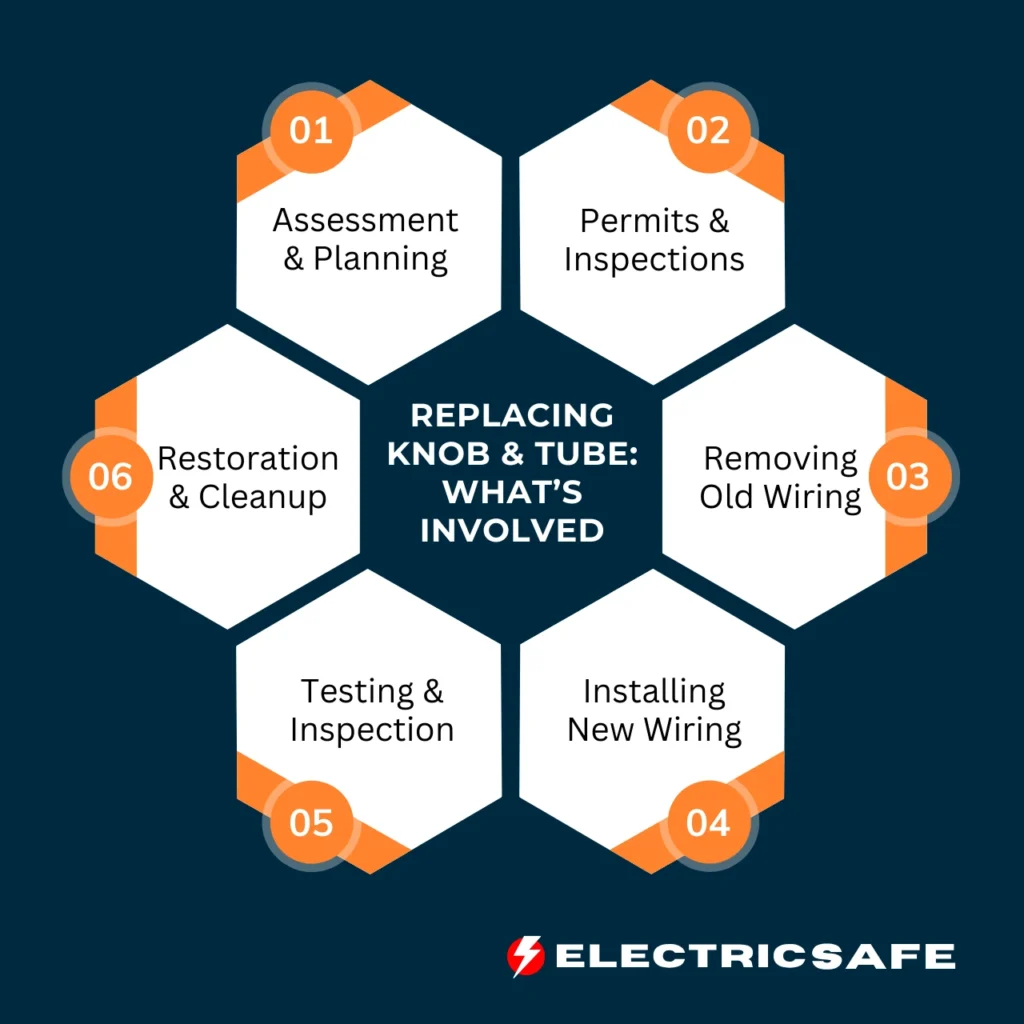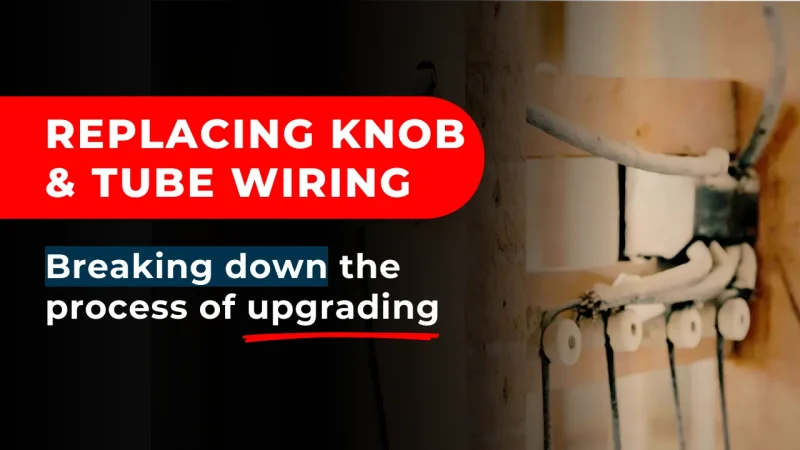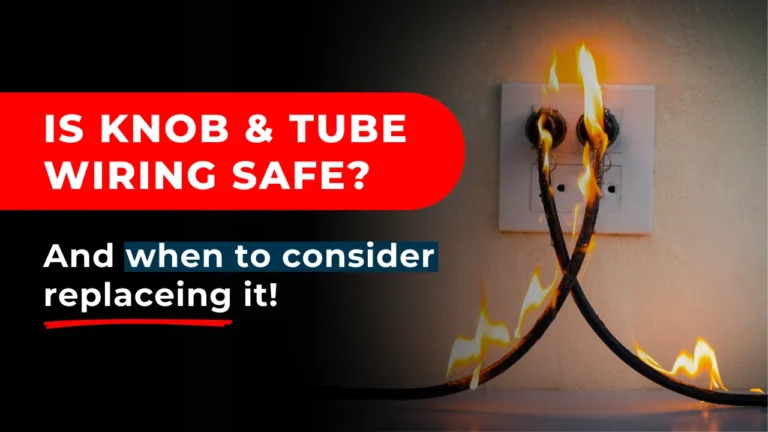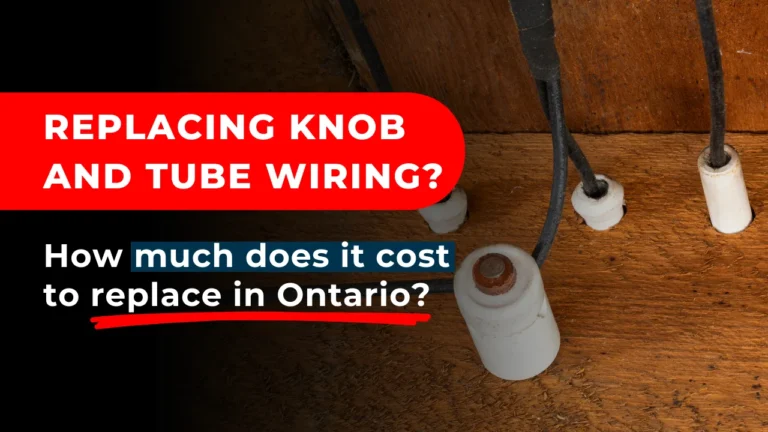If you live in an older home, there’s a good chance it still has knob and tube wiring. This type of wiring was commonly used in homes built between the 1880s and the 1930s and, while it was state-of-the-art back in its day, it’s no longer considered safe and up to electrical codes. If you’re thinking about replacing it, you might wonder what’s involved. This blog will walk you through everything you need to know about replacing knob and tube wiring so you can make an informed decision.

Why Replace Knob and Tube Wiring?
Knob and tube wiring might have done the job in your home for decades, but there are several reasons why it should be replaced with a modern electrical system. To begin with, it wasn’t designed to handle the electrical demands of modern households. Back when it was installed, homes didn’t have the same number of appliances and devices we use today. As a result, knob and tube wiring can easily become overloaded, which increases the risk of electrical fires.
Another reason to replace this wiring is that it lacks a ground wire. Grounding is an important safety feature in modern electrical systems because it helps prevent electrical shocks and fires. Without it, your home is more vulnerable to these hazards. The insulation around knob and tube wiring also tends to degrade over time, leading to exposed wires, which are a major fire hazard.

Finally, if you ever plan to sell your home, having knob and tube wiring can be a deal-breaker for potential buyers. Many home insurance companies won’t even provide coverage for homes with this type of wiring, which can complicate things further.
What’s Involved in Replacing Knob and Tube Wiring?
Replacing knob and tube wiring is not simple or straightforward, which is why it requires careful planning and execution by a licensed electrician. Here’s what you can expect once you schedule a replacement.
1. Assessment and Planning
Replacement of knob and tube wiring begins with an assessment of your home’s current electrical system. An electrician will inspect the wiring to determine its condition, layout, and the extent of the replacement needed. They’ll also check for any other outdated or damaged electrical components that might need to be addressed.
Based on this assessment, the electrician will create a plan for the replacement process. This plan will include details like the estimated time, cost of knob and tube replacement, and any potential challenges that might arise during the project. They’ll also outline the steps they’ll take to ensure your home meets current electrical codes and standards.
2. Permits and Inspections

Before any work can begin, you’ll need to obtain the necessary permits from your local building authority. (Your electrician will handle this part.) Permits are essential because they ensure that the work is done safely and in compliance with local regulations.
Once the permits are secured, the project can move forward. However, keep in mind that your home will be subject to electrical inspections at various stages of the project. These inspections ensure that the work is being done correctly and safely. Your electrician will coordinate them and make any necessary adjustments to the work as required.
3. Disconnecting and Removing Old Wiring
With the permits in hand and the inspections lined up, the electrician will start by disconnecting the old knob and tube wiring from your electrical panel. This step is critical for safety reasons, as it prevents any accidental electrical shocks during removal.
After disconnecting the wiring, the electrician will carefully remove it from your walls, ceilings, and floors. In some cases, this may involve cutting into walls or ceilings to access the wiring. While this can be disruptive, a skilled professional will minimize the damage and ensure that everything is properly repaired once the wiring is removed.
4. Installing New Wiring

Once the old wiring is out, it’s time to install the new one. Your electrician will use modern wiring that meets current safety standards and is designed to handle the electrical demands of today’s homes. This new wiring will also include a ground wire, which provides an additional layer of safety.
During installation, the electrician will carefully run the new wiring through your home’s walls, ceilings, and floors and connect it to your electrical panel and outlets. They’ll also install any necessary junction boxes, outlets, and switches to ensure that your home is fully up to code. As they work, the electrician will distribute the electrical load evenly across multiple circuits to prevent future issues. If needed, they may also upgrade your electrical panel to accommodate the new wiring.
5. Testing and Inspection
After the new wiring is installed, the electrician will thoroughly test the system to ensure that everything is functioning correctly. This includes checking for proper grounding, testing each outlet and switch, and verifying that the electrical panel is distributing power as it should.
Once the electrician is satisfied that the system is working properly, they’ll arrange for a final inspection by the local building authority. This inspection, which is the last step in the process, confirms that the work meets all safety and code requirements.
6. Restoration and Cleanup
After the final inspection, the electrician will focus on restoring your home to its original condition. This includes patching up any holes in your walls or ceilings, repainting as necessary, and cleaning up any debris left behind from the project. The goal is to leave your home looking as good as new, with no sign that any major electrical work was done.
How Long Does the Process Take?
The time it takes to replace knob and tube wiring can vary depending on the size of your home, the extent of the wiring that needs to be replaced, and any challenges that arise during the project.
On average, you can expect everything to take anywhere from several days to a couple of weeks. Your electrician will provide you with a more accurate timeline during the initial assessment and planning phase. Keep in mind that the process may take longer if your home has complex wiring or if additional repairs are needed.
Why You Should Hire a Professional

Replacing knob and tube wiring is not a DIY project. It requires specialized knowledge, tools, and experience to do the job safely and correctly. Attempting to replace knob and tube can be dangerous and could result in serious injury or even death. It can also lead to costly mistakes that could compromise the safety of your home.
Hiring a licensed electrician ensures that the work is done according to code and that your home is safe for you and your family. An experienced electrician will have the skills and expertise needed to handle this type of project and will ensure that everything is done correctly the first time.
Contact ElectricSafe for Professional Knob and Tube Wiring Replacement
If your home still has knob and tube wiring, don’t wait any longer to have it replaced. The risks associated with this outdated wiring are simply too great to ignore. At ElectricSafe in Hamilton, ON, we have the experience and expertise needed to safely and efficiently replace knob and tube wiring in homes of all sizes. We’ll ensure that your home meets all current safety standards and that you’re left with a reliable, modern electrical system you can count on.
Don’t take chances with your safety. Contact ElectricSafe today to schedule an assessment and get started on the path to a safer home.



